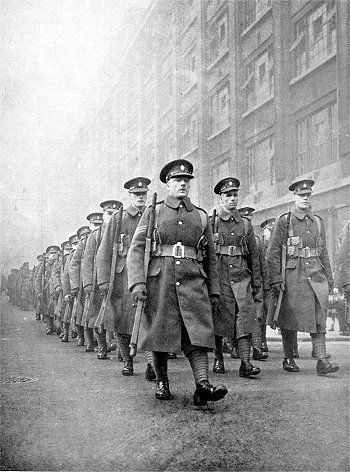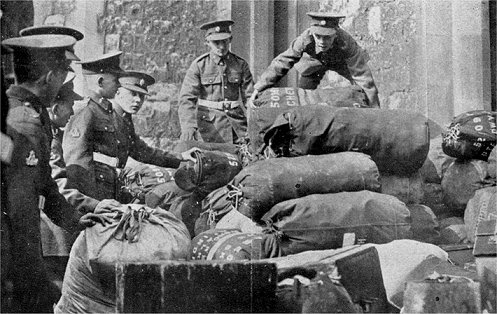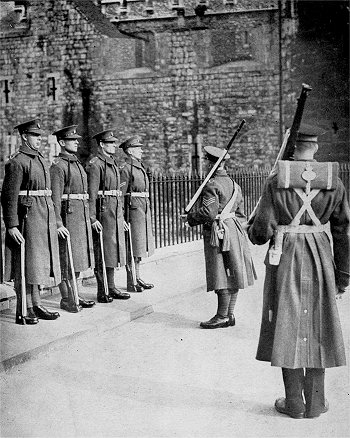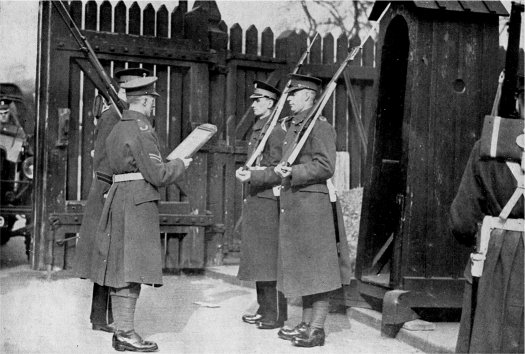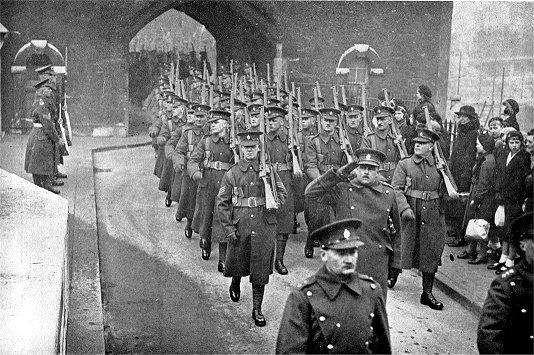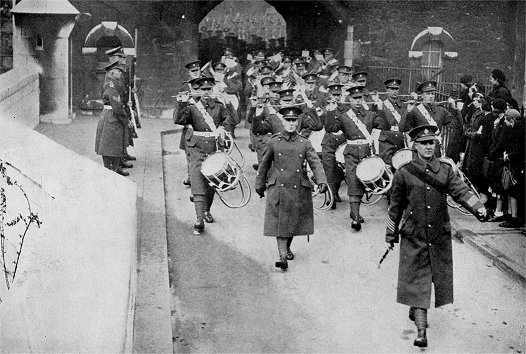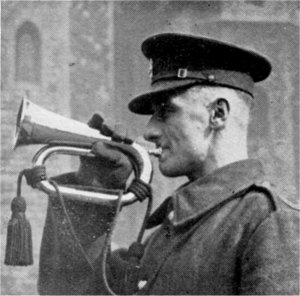1st Battalion Worcestershire Regiment - Guard the Tower of London (1938)
On the 8th March 1938 the men of the 1st Battalion of the Worcestershire Regiment under the command of Lieut.-Colonel S. A. Gabb, marched out of the hustle and bustle of London's streets into the mediaeval atmosphere of the Tower of London. In this ancient fortress, scene of so many tragic and colourful events in English history, the Midland men were to spend the next three months guarding the Tower, while the 2nd Grenadier Guards are away in camp. While the 1st Battalion Worcestershire men were marching through the streets of London on their way to the Tower of London, the Grenadier Guards marched from the Tower to Waterloo Station to entrain for Pirbright. When the Guards reached the Mansion House, the Lord Mayor of London, Sir Harry Twyford, took the salute. The responsibilities undertaken by the 1st Battalion varied from guarding the Crown Jewels to feeding the famous Tower ravens. Legend has it that the ravens are the spirits of people who have died at the Tower. |
The Band and Drums, 1st Battalion Worcestershire Regiment |
1st Battalion Worcestershire marching to the Tower |
Although this is the Worcesters first spell of duty at the Tower, the Midland Battalion is by no means unconnected with the ancient fortress which, through the centuries, has been the scene of so much tragic and colourful history. Appropriately enough, Colonel W. F. O. Faviell, who previously commanded the 1st battalion from 1927 to 1931, was at the time the present Governor of the Tower, a position he held from 1933 to 1945. Also during the Battalion's stay on the 24th May 1938, the Colonel of the Regiment, Field-Marshal Sir Claude W. Jacob, G.C.B., G.C.S.I., K.C.M.G., was installed as the Constable of the Tower of London. On the 26th of May, the officers had the honour of having Field Marshal Sir Claud Jacob and the Lord Mayor of London to dinner. Afterwards, they witnessed the Beating of Tattoo and the Ceremony of the Keys. The Lord Mayor arrived in a coach and pair which lent a medieval atmosphere to the occasion. Another old friend with whom the Worcestershires renewed their acquaintance was ex-Regimental-Sergeant-Major C. Price, D.C.M. who was one of the Tower Wardens (Beefeaters). An interesting fact about the Worcestershire Regiment is its relationship to the Coldstream Guards. It is this that entitled members of the Regiment to wear a star on the backs of their uniforms. The relationship dates back to 1694, when the Midland regiment was raised by Col. Farrington, of the Coldstream Guards. The Worcestershires was one of only three regiments in the British Army who carry a naval crown. This privilege is due to the fact that on the "Glorious First of June," 1794, the Regiment acted as marines in a naval encounter. |
Men of the 1st Worcesters loading their bags in to the Tower of London
Three guards and a Waiting Guard were mounted each day. The Main Guard of one officer and fourteen guarded the Crown Jewels with two sentries by day and four by night; the Wharf Guard with one sentry by day and night guarded the eastern entrance to the Tower and the Wharf and the Spur Guard guarded the main entrance with one sentry by day and night. Daily routine included two main ceremonies. Guard Mounting was taken by the Adjutant on weekdays with the Band in full dress. |
Inspecting the Guard |
The Ceremony of the Keys started with a Yeoman Warder with an escort proceeding to the Middle and Byward Towers to lock the gates on return from which he was challenged by the Sentry on the Main Guard outside the Jewel House: "Halt, who goes there?". "The Keys" replied the Warder. "Whose Keys? " demanded the Sentry. "King George's Keys". "Pass, King George's Keys, all's well". The Main Guard then turned out and presented arms and the Yeoman Warder said "God preserve King George" to which all replied 'Amen". The Keys were then taken to the house of the Resident Governor.
The Band and Drums beat Tattoo once a week prior to the ceremony of the Keys and, twice a week, the Band played a programme of music, once on Tower Green and once on the Wharf.
Men of the 1st Battalion Worcesters - changing guard at the Tower of London
The Battalions sporting activities while at the Tower were rather confined, as the moat encircling the Tower was the only recreation ground. The officers inter-company Football and Hockey strenuously endeavoured to arrange six aside games; but, alas, the ground was so hard and gritty that casualties became too frequent, and the project had to be abandoned. When the cricket season started nets were erected in the moat,and a good |
Sentry at the Tower |
deal of practice was had by most of our cricketers. Several "Away" matches were played, the team being for the most part fairly successful. While the Battalion was in London, all the companies held their sports at Finsbury Park, which was situated quite a long distance away. However, they were transported in lorry loads.
The Main Guard of One Officer and 14 men, guard the Crown Jewels |
On the "Glorious First," a parade was held. The Battalion was inspected by Lieutenant-Colonel W. F. O. Faviell, D.S.O., who commanded the 1st Battalion, and who was then Resident Governor, and Major of the Tower. Colonel Faviell addressed the Battalion:- "Officers and men of the 1st Battalion of the Worcestershire Regiment, it is a great honour for an old Commanding Officer to be asked to inspect the Battalion on one of the Regiment's name days. Name days are very important to a regiment—they foster esprit de corps, which is an essential part of the Regiment's well being. The 1st of June, 1794, would have been a small show in these days, but was, at the time, regarded as a great victory. The Regiment distinguished itself in the Great War, the 2nd Battalion at Gheluvelt — this Battalion (1st) at Neuve Chappelle and on many other occasions. But the Regiment cannot live on tradition—they must always be moving forward—if you live on tradition alone, you will only move backwards—from what I have seen of the Battalion during the three months at the Tower, it is most certainly going forward. |
It is quite possible that many of you here may not be called upon to go on active service during your time in the Army, but if you are, I am confident that you will live up to the high traditions which have made the name of the Regiment in the past."
In the afternoon of the 2nd of June 1938, the married families visited the Tower and went for a river trip, which was kindly arranged by the Port of London Authority. In the evening the Band and Drums beat Tattoo before the "Ceremony of the Keys." C.S.M. J. Keating and his staff laid on a splendid spread, both at lunch time and after the trip.
On June 2nd, the officers of the Battalion were "At Home to past officers of the Regiment, who were able to see the Band and Drums beat Tattoo, and the "Ceremony of the Keys." Judging from comments overheard, the Battalion was found "quite up to the old standard, if not better." |
1st Battalion Worcestershire Regiment on parade at the Tower of London |
On the 3rd June 1938 a party from the Worcestershire Regiment Depot Sergeants Mess visited the Tower and were warmly welcomed by the Sergeants Mess at the Tower. During the evening Mr. Dalloway (the one and only Curly) and Sergeant Lusby made their presence felt in no quiet way.
Colonel W. F. O. Faviell, DSO (Resident Governor) takes the salute on the "Glorious First", 1st July 1938 |
On June 4th 1938, the Sergeants Mess of the 2nd Battalion The Grenadiers Guards and Yeomen Warders were with the 1st Battalion Sergeants Mess for a Euchre Drive and social evening. The prize-winners were as follows:-1st, Yeoman Warder Brenman, 2nd C.S.M. Barrett, 2nd Grenadier Guards; 3rd, Yeoman Warder S. Doney. After the drive C.S.M. Lewis was selected to make a presentation, in the form of a silver inkstand. The inscription read as follows:— "Presented to The Serjeants' Mess, 2nd Battalion The Grenadier Guards, by the Sergeants' Mess, 1st Battalion the Worcestershire Regiment, in appreciation of hospitality received on taking over duties at H.M. Tower of London, 8th March, 1938." R.S.M. Garnett, 2nd Grenadier Guards, most suitably replied, and said that members of our Mess would be welcomed in the 2nd Grenadier Guards' Mess at anytime, he said he was looking forward to the Battalion's move to Aldershot, when he knew that we would be able to renew the friendship.
|
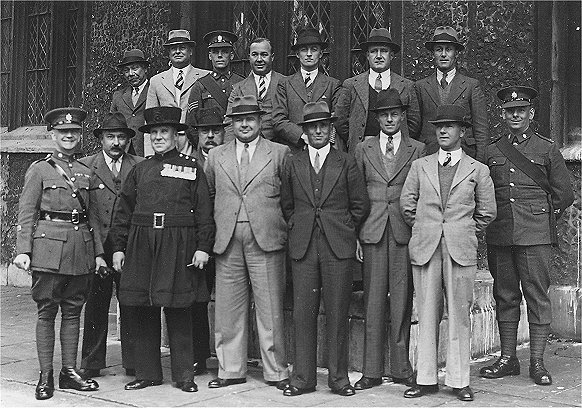
N.C.O.'s of The Depot Worcestershire Regiment visit the Tower of London on 3rd June 1938
Back row: Mr. Marks, L/Sgt. H. Letherbarrow (Depot), Sgt. H. Egan (1st. Bn. 'D' Coy), Mr. Dalloway, L/Sgt. F. Baker (Depot),
Sgt. S. Lusby (Depot, Cook Sgt.), Sgt. A. Rendell (Depot).
Front row: RSM W. Richards (1st Bn.) , Mr. Rea, Yeoman Murphy, Mr. Lester, RSM A. Humphries (Depot), Sgt. G. Mills (Depot),
C/Sgt. C. Ham (Depot - Orderly Room Sgt.), Sgt. F. Hart (Depot), CSM J. Keating (1st. Bn.)
(photo kindly supplied by Brian Ham - son of Colour sergeant C. Ham)
Captain B. R. Moss., M.B.E. (centre saluting) leading 'A' Company men |
Lieut.-Col. S. A. Gabb & Colonel W. F. O. Faviell |
1st Battalion Worcestershire Band and Drums leaving the Tower of London |
|


